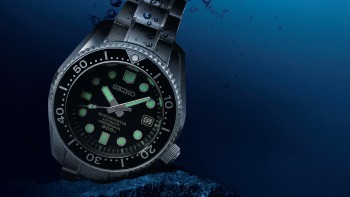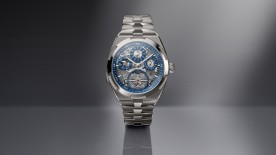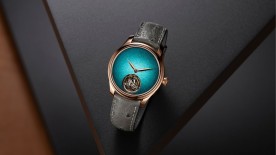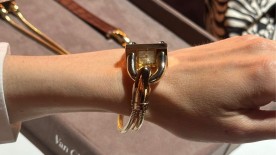Seiko’s first Marinemaster is the epitome of a ‘millennium watch’, arriving on the market in 2000. Purists may note that the Japanese market was actually offered a first iteration of the Marinemaster one year previously in 1999, but that wasn’t a genuine dive watch in the strictest sense of the term. The first proper dive watch by Seiko was indeed the Marinemaster SBDX001 released in 2000, featuring an automatic 8L35 caliber that kept it accurate to within -10 / +15 seconds.
Foundational
The timepiece is now a collectors’ item, although not necessarily as a financial investment: with a retail price of $2,000 20 years ago, it can still be found for $2,000-3,000 today. Its significance is its role in laying out the roadmap that’s come to characterise the Prospex range, of which the Marinemaster SBDX001 was indeed the first professional version.
It says as much on its dial, and very visibly so: the SBDX001 bears the inscription ‘Marinemaster Automatic Professional 300m’, whereas subsequent versions simply feature the Prospex collection’s X-like logo rather than the word Marinemaster. (While often mistaken for an X, the Prospex logo is in fact a merged P and S, the Prospex name being itself a contraction of ‘Professional Specifications’).
The very first Marinemaster may not strictly speaking have been a Prospex, but with it Seiko was already preparing the lineage that was to follow; on the strap, the brand placed a small, temporary yellow sticker bearing the word Prospex — a reference to the specification that would go on to become the actual name of the collection. Subsequently, Seiko has released other SBDX editions that once again bear the original Marinemaster name, in a throwback to the 001 model. These include the SBDX012 anniversary version and the SBDX017.
Pragmatic
he first Marinemaster established a distinctive style, including an imposing single-piece 44mm-diameter case made of steel. From the outset, Seiko opted not to add a helium valve. Despite having no practical use for anybody other than a mere handful of divers worldwide, this touch of vanity does appeal to some collectors in search of authenticity. For its part, in a display of typical Japanese common sense and practical-mindedness, Seiko prefers to be functional, opting for an L-shaped helium-proof seal without a screw-in caseback, that delivers the same result much more simply.
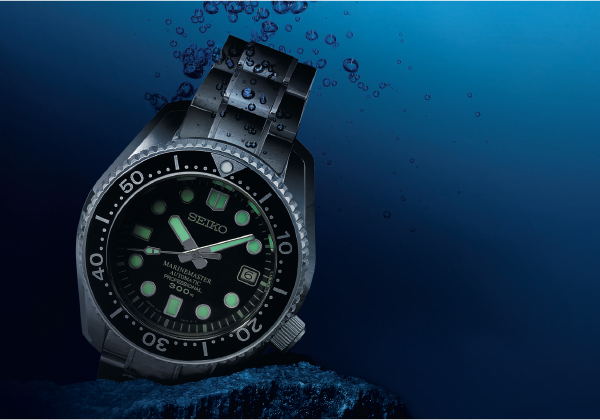
Light
Highly luminous markers for the hours and other indications were another distinguishing feature of the original model. They were to become one of the technical hallmarks of the later Prospex watches for which the Marinemaster SBDX001 prepared the way. Seiko has its proprietary luminous material: rather than the very Swiss Super-LumiNova, its watches use the patented Lumibrite coating, which contains no radioactive substances. One particularity of the first Marinemaster was that the Lumibrite was applied by hand. Connoisseurs appreciate the very slight irregularity due to the artisanal process used, visible under a magnifying glass. Seiko developed a machine application for the following version and all Prospex models, as well as slimming down the markers’ steel surrounds. This made Prospexes cleaner and less rough around the edges, but also deprived them of the ‘hand-made’ look that gives the Marinemaster SBDX001 its special charm.
Strenght
Another almost anachronistic feature is that the 2000 watch was fitted with a crystal made from Hardlex, another Seiko proprietary material. The difference between this and conventional sapphire crystal? None at all. Hardlex wasn’t stronger or less reflective, but was a lot more expensive to produce. Japanese common sense once again prevailed: Hardlex crystal was not used on any subsequent Prospexes.
With each successive edition, Seiko continued to improve its Marinemaster models, notably with ceramic inlays, as well as the sapphire crystal. The Marine-master SBDX001 was also the only ‘pre-Prospex’ watch to feature the unusual high-frequency 8L35 calibre, derived from the prestigious 9S55 to be found in Grand Seiko.
This year GMT Magazine and WorldTempus have embarked on the ambitious project of summarising the divers watch since 2000 in The Millennium Watch Book - Divers watch, a big, beautifully laid out coffee table book. This article is an extract. The Millennium Watch Book - Divers watch is available in both French and English here:
